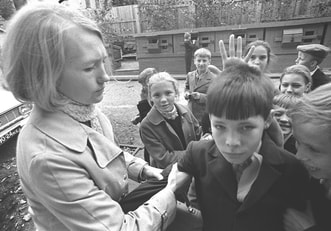Wendell Johnson’s "Monster Study"
By James Donahue
It was back in 1939 that Wendell Johnson, a professor at the University of Iowa, chose a graduate student, Mary Tudor, to assist in conducting a "stuttering" experiment on 22 orphan children in Davenport, Iowa. The experiment was so radical, and produced such terrible results, it became known as The Monster Study.
Under Johnson’s direction, the children were divided into two groups, one was the experimental group and the other was a control group. Ten of the children in the study suffered from speech problems or stuttered at the beginning of the experiment. These children were split apart with five stuttering children in each study group.
During the study, one group of children was given instruction and praise for the fluency of their speech. The other half of the children were given negative speech therapy. These children were belittled for every imperfection that showed up in their speaking ability. They all were told that they were stutterers.
Part of the experiment was to see whether healthy children could become stutterers under certain conditions. Also it was thought that by telling stutterers that their speech was find that their speech problems could be corrected.
The experiment began in January and continued until about June 1, 1939.
At the end of the study, the children in the negative group suffered negative psychological problems and several struggled with speech problems for the rest of their lives. Children that had been considered normal came out of the study withdrawn, silent and anxious when with other people. Their self-confidence was shattered.
All of the children’s schoolwork suffered. Children had difficulty reciting in class. Some simply refused to speak up in the classroom.
Johnson never published the results of the study. The only official record is thus found in Tudor’s dissertation which can be found in the university library.
The story was revealed to the public by an investigative reporter for the San Jose Mercury News in 2001. The news story led to litigation by six of the victims, which continued until 2007. The six were awarded $925,000 by the State of Iowa for lifelong psychological and emotional scars.
Before her death, Tudor expressed regret about her role in the Monster Study. She said she believed Wendell Johnson should have done something to reverse the negative effects the experiment was having on the children. She returned to the orphanage three times in an effort to reverse the negative effects caused by the experiment. She told the Mercury News that she was sorry that she was unable to provide the positive therapy needed to reverse the damage that the experiment caused.
By James Donahue
It was back in 1939 that Wendell Johnson, a professor at the University of Iowa, chose a graduate student, Mary Tudor, to assist in conducting a "stuttering" experiment on 22 orphan children in Davenport, Iowa. The experiment was so radical, and produced such terrible results, it became known as The Monster Study.
Under Johnson’s direction, the children were divided into two groups, one was the experimental group and the other was a control group. Ten of the children in the study suffered from speech problems or stuttered at the beginning of the experiment. These children were split apart with five stuttering children in each study group.
During the study, one group of children was given instruction and praise for the fluency of their speech. The other half of the children were given negative speech therapy. These children were belittled for every imperfection that showed up in their speaking ability. They all were told that they were stutterers.
Part of the experiment was to see whether healthy children could become stutterers under certain conditions. Also it was thought that by telling stutterers that their speech was find that their speech problems could be corrected.
The experiment began in January and continued until about June 1, 1939.
At the end of the study, the children in the negative group suffered negative psychological problems and several struggled with speech problems for the rest of their lives. Children that had been considered normal came out of the study withdrawn, silent and anxious when with other people. Their self-confidence was shattered.
All of the children’s schoolwork suffered. Children had difficulty reciting in class. Some simply refused to speak up in the classroom.
Johnson never published the results of the study. The only official record is thus found in Tudor’s dissertation which can be found in the university library.
The story was revealed to the public by an investigative reporter for the San Jose Mercury News in 2001. The news story led to litigation by six of the victims, which continued until 2007. The six were awarded $925,000 by the State of Iowa for lifelong psychological and emotional scars.
Before her death, Tudor expressed regret about her role in the Monster Study. She said she believed Wendell Johnson should have done something to reverse the negative effects the experiment was having on the children. She returned to the orphanage three times in an effort to reverse the negative effects caused by the experiment. She told the Mercury News that she was sorry that she was unable to provide the positive therapy needed to reverse the damage that the experiment caused.
